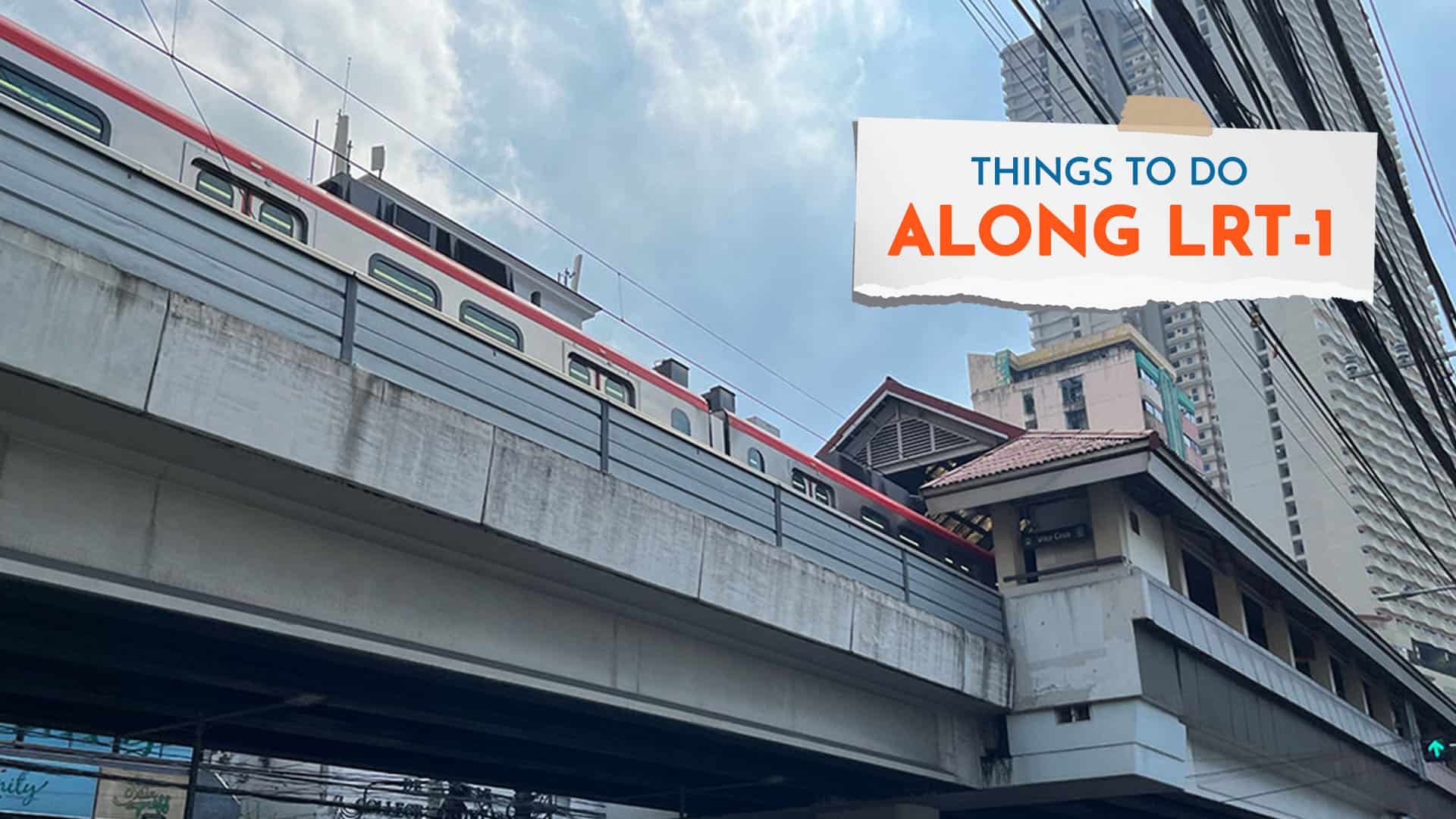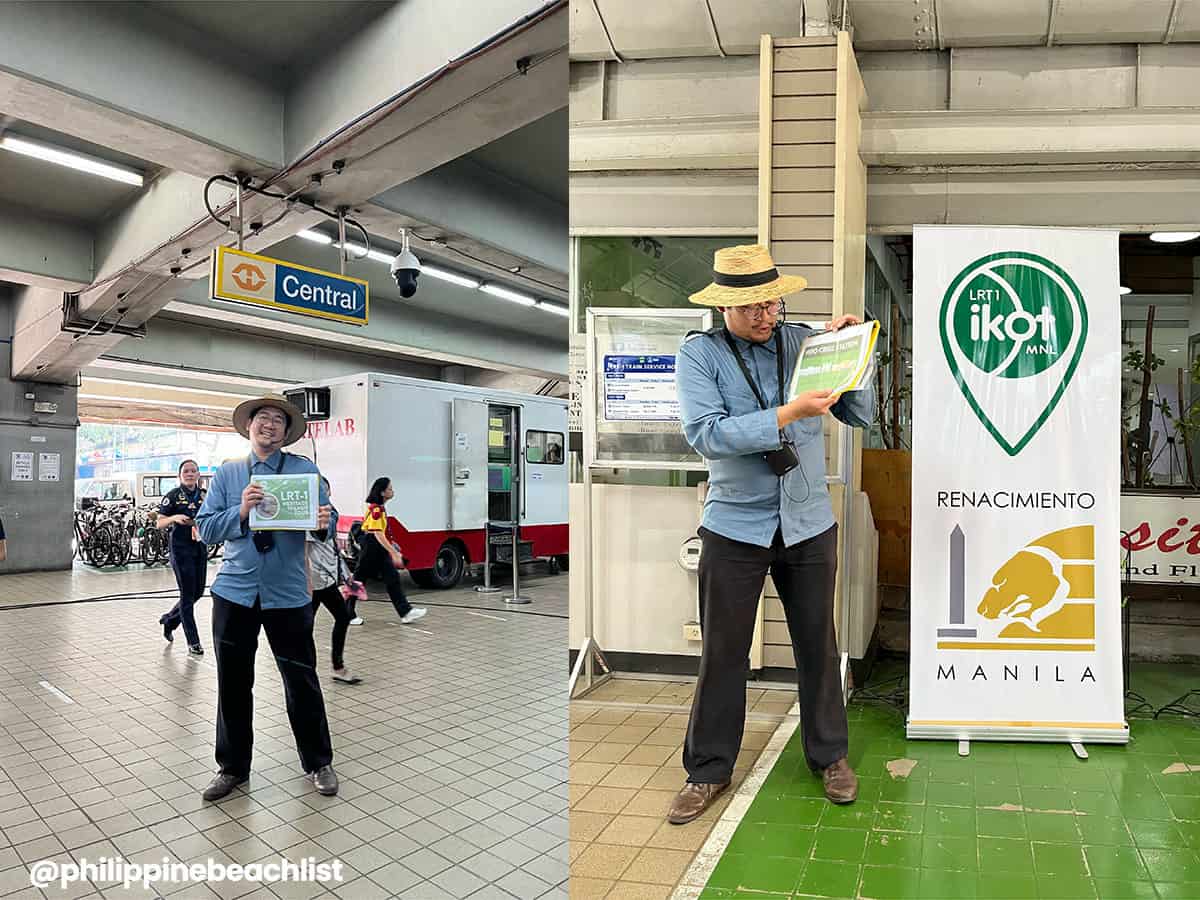
Often, the easiest way to get around Metro Manila is by booking a ride through a ride-hailing app or hailing a taxi. And while this is true for many reasons, taking public transportation is an experience.
Yes, it can be confusing.
And yes, it can easily turn into a nightmare especially if you don’t familiarize yourself with the route.
You’ll find yourself hopping from jeep to bus to train to tricycle just to get to a place that would have taken you 30 minutes by car. But despite these cons, it’s a part of life in Manila.
For tourists and visitors, we dare you to at least try commuting in Metro Manila!
You’ve probably heard of the iconic jeepneys. You might have seen pedicabs or bicycles with a sidecar or its motorized counterpart, the tricycle. There are also buses and public utility vans. But perhaps something more familiar would be the trains.
Multiple train lines go along different areas of Metro Manila and one of them is the LRT-1. A big portion of this train line passes by Manila City, but it also reaches the southern parts of the metro like Pasay and Parañaque. Some of its stops will bring you to some of the best places to visit in Manila. In this post, we’ll list some of the things you can do and places you can visit along LRT-1.
Tip! If you decide to take the train and explore these places, make sure to avoid traveling during rush hour. Save yourself from the chaos!
WHAT'S IN THIS GUIDE?
Things to Do & Attractions
ikotMNL: LRT-1 Heritage Transit Tour by LRMC
Okay, technically, this isn’t a place you can visit near LRT-1. Rather, the Light Rail Manila Corporation’s (LRMC) LRT-1 Heritage Transit Tour is a tour involving the train line itself. This heritage transit tour will take its participants on a journey to some of its stations and historic spots around them. The tour is organized by LRMC, LRT-1’s private operator, in partnership with Renacimiento Manila.
If you’re unsure about your first stop, the heritage transit tour might be a good start. IkotMNL is a guided tour where you will learn about the history of some areas in Manila that this particular train line passes by. From the stations, you’ll walk to nearby historical buildings. During the tour, you will also learn about LRT-1’s history and some interesting facts about Manila as a whole.
Tours are pre-scheduled and cost P500 per person. It is inclusive of a beep card with unlimited LRT-1 rides for the day, a souvenir map, and limited edition ikotMNL merchandise. For more information and bookings, you may reach out to Renacimiento Manila’s Facebook page.
Intramuros
Intramuros is definitely one of the first places on the list of historic sites in Manila. Consider it the capital’s historical epicenter, if you will. After all, Intramuros was once considered the whole city of Manila. During the Spanish colonial period, the city was closed off with thick walls and fortifications to protect it from being invaded by foreign forces.
Today, Intramuros is also referred to as the historic walled city. Inside its walls, you will find numerous historic sites, churches, and more. Some of the most popular sites you can visit here are the Manila Cathedral, San Agustin Church and its museum, Fort Santiago, and Baluarte de San Diego. Other museums you can visit are Casa Manila, Museo de Intramuros, and Destileria Limtuaco Museum.
Intramuros is walkable, but there are other ways to explore the historic complex including bike tour from Intramuros Bambike and an Electric Chariot Tour from White Knight.
And when all else fails, you can just DIY your trip and let your feet (and Google Maps!) take you around the walled city. If you want to know about more things you can do in Intramuros, you can check out this post.
For DIY-ers, you can book an Intramuros Pass via Klook. This pass includes access to Fort Santiago, Casa Manila, Baluarte de San Diego, and Museo de Intramuros at a bundled (and thus discounted!) price. You may also book a Bambike or Electric Chariot Tour in advance through the booking site.
✅ GET YOUR INTRAMUROS PASS HERE!
✅ BOOK INTRAMUROS BAMBIKE TOUR HERE!
Location: Intramuros, Manila City, Metro Manila
Nearest LRT-1 Station: Central Terminal Station
Binondo
For the best eats in Manila, all roads lead to Binondo, Manila’s Chinatown!
This treasure trove of flavorful Chinese staples packs some history as the oldest Chinatown, not just in Manila, but in the world at large. This settlement was established by the Spaniards in 1594 for the Catholic Chinese. It became Manila’s commerce and trade center with different types of businesses operated by Filipino-Chinese families.
Today, a lot of businesses still thrive in Binondo. But tourists will mostly flock to this administrative district for a food crawl. Chinatown’s map is sprinkled with restaurants, hole-in-the-wall food spots, and more. Some of the food places here are already an institution in itself since they’ve been around for generations. If you’re a foodie, make some room in your tummy when you pass by Binondo!
Among the most notable food spots here are Ying Ying Tea House and Wai Ying Fastfood. Both of these places offer noodle dishes, dim sum, congee, and rice meals. Craving chicken? Grab a plate of Sincerity Cafe‘s Chinese-style fried chicken! If you’re looking for lighter meals, head over to Quik-Snack, Shanghai Fried Siopao, or Dong Bei Dumplings. Make sure to take your friends with you because nothing makes a food trip better than doing it with friends!
Location: Binondo, Manila City, Metro Manila
Nearest LRT-1 Station: Carriedo Station
Luneta Park
Situated in Ermita, Luneta is also known as Rizal Park, named in honor of the Philippine National Hero, Jose Rizal. It is in this place — formerly called Bagumbayan -— where Rizal was executed in 1896. Rizal’s monument also stands in the park, serving as its focal point.
Luneta is one of the largest urban parks in the country. Inside the park, you will find several gardens to explore. The Chinese Garden with its ornate Chinese-style gate will surely catch your attention. You can also stroll around the Japanese Garden, Children’s playground, and Noli Me Tangere Garden. If you have an affinity for plants, you would want to check out the Orchidarium and Butterfly Pavilion. The pavilion showcases Philippine orchid species and butterflies.
Other points of interest in the park are: the Diorama of Rizal’s Martyrdom where Rizal’s execution is depicted, the Gallery of Heroes which consists of bust sculptures of numerous Philippine heroes, and a musical dancing fountain. You will also find kilometer zero near the Rizal monument. This marker serves as the starting point from which distances of different places in the Philippines from Manila are measured.
Although it is usually the park itself that’s referred to as Luneta, it also covers its surrounding areas. Among the other sites located within Luneta is the Quirino Grandstand where Philippine Presidents traditionally take their oath of office. The national museums, namely the National Museum of Fine Arts, National Museum of Natural History, and National Museum of Anthropology is also located within Luneta.
Location: Ermita, Manila City, Metro Manila
Nearest LRT-1 Station: United Nations Station
Cultural Center of the Philippines Complex (CCP Complex)
Commonly referred to as CCP, the Cultural Center of the Philippines Complex is a mixed-use cultural and tourism hub. Located along Roxas Boulevard and the Manila Bay, the complex is part of the Bay City. It is managed by the Cultural Center of the Philippines, an institution that preserves, develops, and promotes arts and culture in the country.
CCP is home to several buildings, some of which are designed by Leandro Locsin, a National Artist of the Philippines for Architecture. These include the Tanghalang Pambansa, Philippine International Convention Center, and Sofitel Philippine Plaza Manila which were designed with a brutalist style architecture. Other structures in the complex are Star City, Harbour Square, Coconut Palace, and the controversial Manila Film Center.
When one says “CCP,” one often remembers Tanghalang Pambansa. Also called the Theater of Performing Arts, the place holds multiple performing arts venues. The main theater or Tahanang Nicanor Abelardo is the largest with four levels for its audience. Meanwhile, the Tanghalang Aurelio Tolentino (Little Theater), Tanghalang Huseng Batute (Studio Theater), and the Tanghalang Manuel Conde (Dream Theater) are used for smaller performances and screenings. Inside Tanghalang Pambansa, you will also find a museum, galleries, and CCP’s library and archives.
Location: Roxas Boulevard, Pasay City, Metro Manila
Nearest LRT-1 Station: Vito Cruz Station
Arroceros Forest Park
As the only nature park in the capital city, Arroceros Forest Park gained the monicker “Manila’s Last Lung.” It is located in Ermita, along Antonio Villegas Street, formerly known as Calle Arroceros. Sitting on the south bank of the Pasig River, it is in an area that’s formerly a part of Parian. During the Spanish colonial period, Parian District served as the Chinese trading settlement in Manila.
Arroceros Forest Park opened to the public in 1993. It is under the administration of the city government and Winner Foundation, the private environmental group that developed the nature park. The park houses countless varieties of trees and plants including fruit trees and ornamental plants. It also serves as a habitat for multiple bird species. Its landscape is designed by landscape architect Wilfrido Dizon.
In 2003, the park temporarily closed for the construction of a school administration building and teacher’s dormitory. This became the root of controversy as this resulted in thousands of trees being cut down. The nature park was reopened in 2007, only to be threatened again in 2017. Winner Foundation was ordered to vacate the park by the city government to make way for the construction of a gymnasium.
Fortunately, an online petition led to the construction being suspended and saved the park. In 2020, a city ordinance named Arroceros Forest Park Ordinance was signed to designate the park as a permanent forest park. The ordinance gives protection to the park and prohibits cutting of trees, dumping of waste, and excavation in the area.
Location: Antonio Villegas Street, Ermita, Manila City, Metro Manila
Nearest LRT-1 Station: Central Terminal Station
Quiapo Church
Located at the heart of Manila City, Quiapo is also known as the Old Downtown of the city. This district in Manila is known for Quiapo Church. Formally called the Minor Basilica and National Shrine of the Black Nazarene, Quiapo Church is home to the Black Nazarene. Devotees of this life-size image of a dark-skinned Jesus Christ believe that it is miraculous. Its feast is celebrated annually in January with millions of people joining the procession.
The history of Quiapo Church can be traced back to the 16th century. Like many catholic churches in the country, it has been destroyed and reconstructed multiple times. The present structure that we see today was constructed starting 1933 and was completed in 1935. However, changes were made when the church was expanded between 1984 to 1986 to accommodate more devotees. Despite the changes, the church’s facade remains, which means that you can still appreciate its Baroque style architecture today.
When you visit Quiapo Church, you’ll probably witness the devotion of many Filipino Catholics to Nuestro Señor Jesus Nazareno. Every Friday, the church holds a novena in honor of the Black Nazarene referred to as Quiapo Day. The church is always packed on these days with devotees who come with their prayer petitions. On other days, the church may be not as packed, yet you’ll still witness many devotees who go to kiss the foot of the Nazareno or wipe their handkerchiefs upon his toes.
Location: Plaza Miranda, Quiapo, Manila City, Metro Manila
Nearest LRT-1 Station: Carriedo Station
National Museum Complex
Sitting within Luneta is the National Museum Complex. This refers to the central museums of the National Museum of the Philippines. Four museums are a part of the complex including the now closed National Planetarium, which was a space museum. The three other museums are operational and are accessible to the public.
Founded in 1998, you’ll find the National Museum of Fine Arts, in the Old Congress Building. Previously referred to as the National Art Gallery, it houses a collection of paintings and sculptures by many Filipino artists. Upon entering the museum, Spoliarium, spanning the width of the room, will greet you. Familiar names like Fernando Amorsolo, Felix Resurreccion Hidalgo, and Nena Saguil will pop up throughout your tour.
Meanwhile, the National Museum of Anthropology holds ethnological and archaelogical exhibits. Once known as the Museum of the Filipino People, it now occupies what was once known as the Department of Finance. Inside the building are five floors filled with galleries and offices. Among the exhibits found here are the Marble Hall and Manlilikha ng Bayan Hall. You will also see displays that highlight the culture of different parts of the country like Mindanao and Northern Luzon.
The latest museum that opened its doors is the National Museum of Natural History. Established in 2017, it is located in the building that was formerly used by the Department of Tourism. The building was renovated in 2015 and now features a glass dome that lets a lot of natural light in. From the inside, you will see the dome and its supporting structure, and together, they’re called the “Tree of Life”. The galleries are spread across six floors of the building. Here, you will learn about flora and fauna in the Philippines, among other natural history exhibits.
Location: Ermita, Manila City, Metro Manila
Nearest LRT-1 Station: United Nations Station
Baclaran Church
Formally called the National Shrine of Our Mother of Perpetual Help, Baclaran Church is located in Baclaran, Parañaque City. The national shrine is dedicated to Our Lady of Perpetual Help and also acknowledged as the Redemptorist Church. Historically, the shrine was first dedicated to Saint Therese of Lisieux or Saint Therese of the Child Jesus.
However, this changed when a high altar was donated by the Ynchausti family and friends while the church was being built. The donation came with the condition that the image of Our Mother of Perpetual Help be enshrined on the high altar. Today, an image of Saint Therese of the Child Jesus stands on the grounds of the shrine.
On Wednesdays, more devotees flock the shrine as this is the church’s day for novena. It is locally known as Baclaran Day. If you want to avoid the crowd when visiting the shrine, avoid going Wednesdays! This way, you can appreciate the Modern Romanesque architecture of the church without having to squeeze through thick crowds. Some distance from the church is its belfry, built in 2015. This was the first bell tower of the shrine since it was first established.
Location: Redemptorist Road, Baclaran, Parañaque City, Metro Manila
Nearest LRT-1 Station: Baclaran Station
Harbour Square
Situated within the CCP Complex, near the border between Pasay City and Manila City, Harbour Square is a plaza by the bay. Aside from multiple restaurants, bars, and coffee shops, the square has a relaxing ambiance since it sits right by the bay. It’s best to come here around late afternoon when the sun isn’t too hot anymore and wait for the sunset. Adding to the view of the Manila skyline are the yachts docked along the bay.
Harbour Square give off a romantic vibe which makes it ideal as a date spot for couples. But be warned: as the night rolls in and the resto bars open up, the area can get quite loud with music. Restaurants here range from fast food to eat-all-you can food spots. When you go to harbor square, you can walk to visit the Tanghalang Pambansa (CCP). It houses a museum and galleries, or you can catch a show on the theater.
Location: Malate, Manila City, Metro Manila
Nearest LRT-1 Station: Vito Cruz Station
Paco Park
During the Spanish colonial period, Paco Park was a municipal cemetery called Cementerio General de Dilao. The cemetery was constructed in the 19th century after the cholera epidemic. It was used by affluent families who lived in Intramuros during the Spanish era. Then in 1912, interment at the cemetery halted and most of the remains buried here were exhumed. This includes the national hero Jose Rizal who was buried in Paco Cemetery from December 1896 to December 1912.
At present, the former cemetery is now a recreational garden in Paco, Manila. This was converted in 1966 and declared as a national park. The circular fort that was a part of the original cemetery still remains a part of the park. Inside, you will find a small chapel dedicated to St. Pancratius.
Location: Belen, Paco, Manila City, Metro Manila
Nearest LRT-1 Station: United Nations Station
Where to Stay in Manila
You can book a stay with the two hotels within Intramuros. However, there are more hotel options in other areas in the City of Manila like Ermita and Malate. Below are some of the hotels you can book for your stay in Manila.
Top Hotels on Agoda
- WHITE KNIGHT HOTEL INTRAMUROS
✅ Check Rates & Availability Here! - THE MANILA HOTEL
✅ Check Rates & Availability Here! - ADMIRAL HOTEL MANILA – MGALLERY
✅ Check Rates & Availability Here! - NEW COAST HOTEL MANILA
✅ Check Rates & Availability Here! - DIAMOND HOTEL
✅ Check Rates & Availability Here!
Top Hotels on Hotels.com
- THE BAYLEAF INTRAMUROS
✅ Check Rates & Availability Here! - RIZAL PARK HOTEL
✅ Check Rates & Availability Here! - SHERATON MANILA BAY
✅ Check Rates & Availability Here! - BAYVIEW PARK HOTEL MANILA
✅ Check Rates & Availability Here! - TROPICANA SUITES
✅ Check Rates & Availability Here!
You can also check out these posts for more hotel suggestions around Manila:
- Top 10 Hotels in Ermita
- Top 10 Hotels in Malate
- Top 10 Hotels Near Manila Bay
- 10 Historic Hotels in Metro Manila
Find more Manila Hotels!
Updates Log
2023.12.29 – Updated Where to Stay section
2023.11.19 – First published
Related Articles: How to Get from Manila Airport (NAIA) to MANILA CITY CENTER
More Tips on YouTube ⬇️⬇️⬇️






Comments